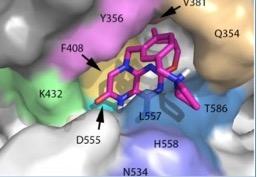Remember Gilead, that wicked company that dared to cure hepatitis C and made a bunch of money doing so? If this doesn't ring a bell, go back a couple of decades. Perhaps you'll remember the company's anti-HIV drugs, you know, the ones that have essentially removed the term "AIDS" from the American vernacular (1) and are expected to completely end all new infections and deaths in Africa by 2030.
But despite four decades of research and one failed vaccine after another, AIDS has not been cured, only controlled. People who are HIV-positive must still take antiretroviral drugs for the rest of their lives to suppress the virus. But that could finally change. Gilead put a whole lot of that money back into research and, in doing so, may eventually "put themselves out of business." That's a bit optimistic for the moment, however, Gilead in conjunction with the Beth Israel Deaconess Medical Center have done something new, which at least suggests that HIV could one day be cured.
At the recent Conference on Retroviruses and Opportunistic Infections in Boston, Dan Barouch, M.D., Ph.D of Beth Israel spoke about an unprecedented advance in controlling HIV. By combining an antibody called PGT121 with Gilead's GS-9620 TLR7 agonist (2), a direct acting antiretroviral experimental drug, some remarkable results were seen in rhesus macaques that had been infected an HIV-like virus that also infects monkeys. Some of the monkeys (5 of 11) remained "virus free" (3) 168 days after the drug combination was stopped. This has never happened before.
The job of GS-9620 is to force latent HIV from their immune cell reservoir. Then PGT121 can attach to the virus and clear it from the blood. If it sounds like both drugs are needed it's because they are. Neither drug alone did much of anything. The binding of GS-9620 to the TLR7 receptor is shown in Figure 1.
Figure 1. Left: The chemical structure of GS-9620. Center: GS-9620 bound to the TLR7 receptor. Right: A close up of the GS-9620 at its binding site. Note the very good fit between the drug (magenta) and the receptor (receptors are proteins.) The letters are abbreviations for the amino acids that form the protein. Each of the 20 amino acids that are the building block of proteins has its own abbreviation. For example, Y means tyrosine, V means valine, etc. The numbers refer to the linear position of the amino acid in the protein. So, D555 means that an aspartic acid is found in the 555th position from the end of the protein chain. But proteins are three-dimensional and they twist, turn and fold. The position of amino acids within the chain tells nothing about the size or shape of the protein. Source: " Molecular Determinants of GS-9620-Dependent TLR7 Activation" PLOS ONE, January 2016
Even if things go perfectly we are still (at best) years from a cure, but the synergistic effect of these two drugs provides "proof of concept," a critically important milestone in drug development. Meanwhile, Gilead isn't sitting still. The company discovered GS-9722, a different antibody that may be superior to PGT121, which is now in Phase I trials, as is the GS-9620-PGT121 combination.
Good for them. You too.
NOTES:
(1) In 2014, the last year with complete records, there were 6,721 deaths directly attributable to HIV in the US 2014, an 86% reduction from 1995, the worst year on record.
(2) TLR7 is short for Toll-like receptor 7. When the receptor is activated (this is the function of GS-9620) it forces HIV out of reservoirs in immune cells. Then the antibody can clear the virus from the blood.
(3) "Virus free" is an expression which is not technically correct. It refers to levels of HIV that are so low that they cannot be measured.




